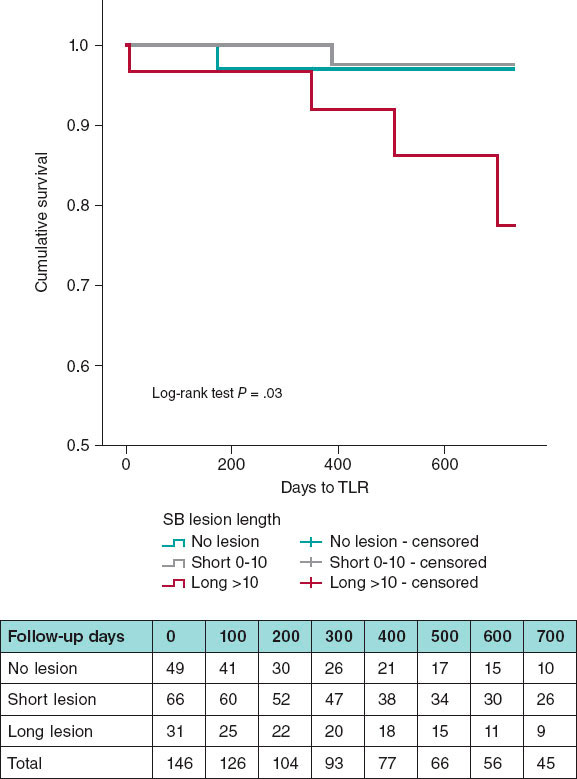To the Editor,
Treatment failure is a major concern after full metal jacket (FMJ) stenting procedures, defined as overlapping stent length ≥ 60 mm. These procedures are often required to treat tandem or extensive coronary lesions.1 Several brands of stents are currently approved, each displaying different characteristics and performance. However, real-world practice is not restricted to the use of a brand exclusive strategy and may involve a combination of different brands. Limited data exist on the relative safety and efficacy of these different strategies during percutaneous coronary intervention (PCI). Therefore, our aim was to compare clinical outcomes after the use of a single stent brand vs multiple stent brands following successful FMJ PCI.
From a dedicated database of 23 021 consecutive PCI procedures performed between January 2002 and December 2018 at a high-volume coronary intervention laboratory, we retrospectively identified 592 patients (3%) who underwent FMJ procedures. Written informed consent was obtained from all patients. Stent selection was left to the operator’s discretion. We excluded patients with unsuccessful procedures and those lost to follow-up from the analysis. Demographic, clinical, angiographic, and procedural variables were evaluated. The primary endpoint consisted of major adverse cardiac events (MACE), which included all-cause death, myocardial infarction (MI), and target vessel revascularization (TVR). The secondary endpoint was target lesion failure (TLF), a composite of cardiac death, target vessel-related MI (TV-MI), and target lesion revascularization (TLR). Stent thrombosis and in-stent restenosis were also assessed. Clinical follow-up was conducted via telephone and hospital records were reviewed.
Univariate and multivariate Cox regression analysis were performed to determine independent predictors of outcome. All reported P values are 2-tailed, with a P value < .05 indicating statistical significance. Data were analyzed using IBM SPSS for Windows (version 25.0).
The study cohort included 353 patients, with a mean age 65.4 ± 11.4 years. Most of the patients were male (78%), presented with chronic stable angina (55%), and had a history of hypertension (77%) and dyslipidemia (74%). A significant percentage of the patients had clinically overt cardiovascular disease (38%), including prior MI (24%), previous coronary revascularization with PCI (23%), or coronary artery bypass grafting (10%). Among the patients, 51 (14%) had left ventricular dysfunction (ejection fraction < 40%) and 63% had multivessel disease.
FMJ procedures were primarily performed via femoral access (71%) and targeted the right coronary artery in 57% of cases. The main indications were diffuse lesions (59%), followed by tandem lesions (23%) and dissection (10%). Ostial lesions, bifurcations, chronic total occlusions (CTO), and in-stent restenosis comprised 16%, 10%, 9%, and 7% of the procedures, respectively. Intracoronary imaging was used in 10% of the cases.
The mean number of stents was 2.95 ± 0.80 [range 2 to 6], the mean stent length was 74.3 ± 14.2 mm [range 60 to 132 mm], and the mean stent diameter was 2.88 ± 0.35 mm. Drug-eluting stents (DES) were used in 304 patients (86%), with contemporary third-generation DES accounting for 53% of the stents used. An exclusive brand strategy was employed in 45% of the procedures. In this group, the antiproliferative agents used were everolimus (56%), sirolimus (23%), zotarolimus (14%), umirolimus (5%), and paclitaxel (3%).
During the mean follow-up period of 5.0 ± 3.9 years, the incidence of MACE was 46% and the TLF rate was 32%. The all-cause mortality rate was 26%, of which 11% were cardiac deaths. The rates of MI and TV-MI were 16% and 11%, respectively. TVR occurred in 19% of the patients and TLR in 17%. The rates of stent thrombosis and in-stent restenosis were 4% and 22%, respectively.
Multivariate Cox analysis identified the use of a brand exclusive strategy as the only procedural-related protective factor for TLF (hazard ratio [HR], 0.552; 95% confidence interval [95%CI], 0.361-0.844; P = .006). When FMJ was performed using third-generation DES, over a mean follow-up of 3.1 ± 1.9 years, the occurrence rates of MACE and TLF were 36% and 23%, respectively. Similarly, after multivariate adjustment, the use of a single brand strategy demonstrated a protective effect for TLF (HR, 0.444; 95%CI, 0.226-0.874; P = .019). There were no significant differences in procedural outcomes between distinct antiproliferative drugs or stent brands.
Clinical outcomes were then compared between the groups receiving a single stent brand and those receiving multiple stent brands (table 1). In the overall cohort, the use of a single stent brand resulted in a lower rate of MACE but this result was not statistically significant (HR, 0.735; 95%CI, 0.535-1.009; P = .057). However, the use of a single brand strategy demonstrated a protective effect against in-stent restenosis (HR, 0.458; 95%CI, 0.280-0.747; P = .002) and TLF (HR, 0.558; 95%CI, 0.378-0.824; P = .003). In FMJ using third-generation DES, brand exclusivity was found to be associated with a reduced incidence of TLF (HR, 0.432; 95%CI, 0.220-0.850; P = .015) and lower rate of MACE, although this result was not statistically significant (HR, 0.594; 95%CI, 0.353-1.000; P = .050).
Table 1. Long-term outcomes following full metal jacket procedure according to study groups
| Events | All (n = 353) | Bare metal stents (n = 49) | First-generation DES (n = 35) | Second-generation DES (n = 107) | Third-generation DES (n = 162) | ||||||||||
|---|---|---|---|---|---|---|---|---|---|---|---|---|---|---|---|
| EBS group (n = 159) | MBS group (n = 194) | P value | EBS group (n = 18) | MBS group (n = 31) | P value | EBS group (n = 24) | MBS group (n = 11) | P value | EBS group (n = 32) | MBS group (n = 75) | P value | EBS group (n = 85) | MBS group (n = 77) | P value | |
| n (%) | n (%) | n (%) | n (%) | n (%) | n (%) | n (%) | n (%) | n (%) | n (%) | ||||||
| MACE | 63 (40) | 98 (51) | .057 | 12 (67) | 21 (68) | .945 | 14 (58) | 6 (55) | .540 | 12 (38) | 38 (51) | .049 | 25 (29) | 33 (43) | .050 |
| Death | 34 (21) | 56 (29) | .135 | 3 (17) | 10 (32) | .288 | 7 (29) | 4 (36) | .808 | 8 (25) | 20 (27) | .685 | 16 (19) | 22 (29) | .153 |
| MI | 22 (14) | 34 (18) | .334 | 6 (33) | 10 (32) | .969 | 6 (25) | 1 (9) | .227 | 2 (6) | 10 (13) | .179 | 8 (9) | 13 (17) | .118 |
| TVR | 24 (15) | 43 (22) | .075 | 5 (28) | 8 (26) | .952 | 8 (33) | 3 (27) | .577 | 4 (13) | 21 (28) | .027 | 7 (8) | 11 (14) | .184 |
| TLF | 38 (24) | 76 (39) | .003 | 9 (50) | 19 (61) | .573 | 7 (29) | 6 (55) | .563 | 9 (28) | 27 (36) | .211 | 13 (15) | 24 (31) | .015 |
| Cardiac death | 11 (7) | 27 (14) | .039 | 2 (11) | 7 (23) | .339 | 2 (8) | 1 (9) | .965 | 2 (6) | 8 (11) | .477 | 5 (6) | 11 (14) | .087 |
| TV-MI | 13 (8) | 25 (13) | .151 | 3 (17) | 7 (23) | .598 | 6 (25) | 1 (9) | .227 | 1 (3) | 9 (12) | .106 | 3 (4) | 8 (10) | .083 |
| TLR | 23 (15) | 38 (20) | .160 | 5 (28) | 8 (26) | .952 | 7 (29) | 3 (27) | .760 | 4 (13) | 17 (23) | .076 | 7 (8) | 10 (13) | .272 |
| Stent thrombosis | 8 (5) | 7 (4) | .509 | 2 (11) | 3 (10) | .897 | 6 (25) | 1 (9) | .227 | 0 (0) | 1 (1) | .695 | 0 (0) | 2 (3) | .457 |
| In-stent restenosis | 23 (15) | 53 (27) | .002 | 6 (33) | 15 (48) | .271 | 2 (8) | 6 (55) | .034 | 7 (22) | 21 (28) | .205 | 8 (9) | 11 (14) | .241 |
|
DES, drug-eluting stents; EBS, exclusive brand strategy; MACE, major adverse cardiac events; MBS, multiple brand strategy; MI, myocardial infarction; TLF, target lesion failure; TLR, target lesion revascularization; TV-MI, target vessel-related myocardial infarction; TVR, target vessel revascularization. |
|||||||||||||||
A wide range of stents from various companies are currently available for clinical use, differing in their metal platform, polymer coating, and antiproliferative drug. While these stents generally have similar safety and efficacy, certain stents may perform better in some complex lesions, such as ostial, bifurcation, calcified, CTO, or long lesions that may require FMJ stenting.2 Our study shows that FMJ PCI is associated with an acceptable, but nonnegligible, rate of events. The 1-year incidence of MACE was 15.6% (12.9% with the use of new-generation DES), which is in agreement with other published results.3-5
After multivariate adjustment, the use of a single brand strategy resulted in better outcomes in terms of in-stent restenosis and TLF. In addition, there was a trend toward lower MACE rates. Brand exclusivity remained a favorable strategy in the current-generation DES era. Of note, no particular stent brand demonstrated superiority over the others. Similarly, the eluted drug per se did not appear to play a significant role in determining clinical outcomes.
These findings suggest that procedural outcomes following successful FMJ procedures are not influenced solely by a specific stent design or composition. Rather, they appear to be influenced by the combination of distinct stent profiles, differing in their physical, biological, and pharmacological properties, which may potentially lead to detrimental effects and influence outcomes.
This study provides novel results. However, several limitations must be acknowledged, mainly related to the retrospective, single-center and nonrandomized design. There was considerable loss to follow-up (37%), which may have led to bias. Therefore, these findings require validation in future dedicated trials.
In summary, our findings indicate that TLF is reduced by the use of a brand exclusive strategy in FMJ procedures, including in the era of third-generation DES. This suggests that avoiding a combination of different stent brands may be beneficial in this setting.
Informed consent was obtained from all participants involved in the study. The study was carried out in accordance with the principles of the Declaration of Helsinki and was approved by the local ethics committee.
FUNDING
None declared.
ETHICAL CONSIDERATIONS
The study was carried out according to the principles of the Declaration of Helsinki and approved by the local ethics committee. Informed consent was obtained from all subjects involved in the study. The possible variables of sex and gender have been taken into account in accordance with the SAGER guidelines.
STATEMENT ON THE USE OF ARTIFICIAL INTELLIGENCE
Artificial intelligence was not used for the development of this work.
AUTHORS’ CONTRIBUTIONS
J.M. Viegas was the major contributor in drafting the manuscript. The remaining authors revised the manuscript. All authors read and approved the final manuscript.
CONFLICTS OF INTEREST
None declared.
REFERENCES
1. Lee CW, Park KH, Kim YH, et al. Clinical and Angiographic Outcomes After Placement of Multiple Overlapping Drug-Eluting Stents in Diffuse Coronary Lesions. Am J Cardiol. 2006;98:918-922.
2. Parker W, Iqbal J. Comparison of Contemporary Drug-eluting Coronary Stents –Is Any Stent Better than the Others?Heart Int. 2020;14:34.
3. Sharp ASP, Latib A, Ielasi A, et al. Long-Term Follow-Up on a Large Cohort of “Full-Metal Jacket“Percutaneous Coronary Intervention Procedures. Circ Cardiovasc Interv. 2009;2:416-422.
4. CaléR, Teles RC, Almeida M, et al. Percutaneous Coronary Intervention using a Full Metal Jacket with Drug-eluting Stents:Major Adverse Cardiac Events at One Year. Arq Bras Cardiol. 2013;101:117-126.
5. Lee CW, Ahn JM, Lee JY, et al. Long-term (8 year) outcomes and predictors of major adverse cardiac events after full metal jacket drug-eluting stent implantation. Catheter Cardiovasc Interv. 2014;84:361-365.











